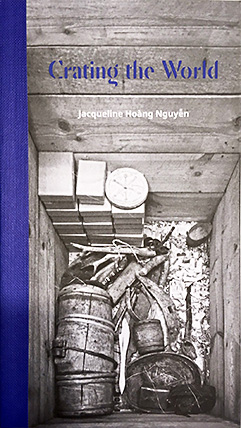Crating the World
The book Crating the World aims to expose the labour performed by indigenous peoples needed for the transport of their own material culture to Western museums in anonymous crates.
 Crating the World functions as a hybrid between an artist book documenting the Jacqueline Hoàng Nguyễn's artistic research for the exhibition Black Atlas (2016)––the outcome of a year-long SWICH artist-in-residence at the Museum of Ethnography in Stockholm (2015)––and a compendium of new essays. SWICH- Sharing a World of Inclusion, Creativity and Heritage - is a four-year collaborative project involving ten European museums of Ethnography and World Cultures, with the aim of creating dialogues on citizenship and belonging in contemporary Europe. Under the subtheme "Stereoculture: the Art of Listening" four European partner museums host residencies for artists/experts/curators to develop critical perspectives on their practices, exhibitions and collections.
Crating the World functions as a hybrid between an artist book documenting the Jacqueline Hoàng Nguyễn's artistic research for the exhibition Black Atlas (2016)––the outcome of a year-long SWICH artist-in-residence at the Museum of Ethnography in Stockholm (2015)––and a compendium of new essays. SWICH- Sharing a World of Inclusion, Creativity and Heritage - is a four-year collaborative project involving ten European museums of Ethnography and World Cultures, with the aim of creating dialogues on citizenship and belonging in contemporary Europe. Under the subtheme "Stereoculture: the Art of Listening" four European partner museums host residencies for artists/experts/curators to develop critical perspectives on their practices, exhibitions and collections.
The publication uses the exhibition Black Atlas as a point of departure for a reflection upon the historical and ideological constructions of material culture through collecting and photographic practices and subsequent knowledge production in Western museums.
The texts offer critical analyses of Western museum practices alongside Jacqueline Hoàng Nguyễn's artistic interventions, supplemented by an in-depth interview with curator Ulrika Flink .
An essay by art historian and researcher Åsa Bharathi Larsson delves into Sweden’s colonial fever and imperial ambitions, illuminating the intersections between material culture studies, the history of collecting foreign cultures inrelation to knowledge production, and underlying racialised hierarchies.
Ariella Azoulay’s essay discusses the circulation of material culture from colonised countries to Western museums, focusing on local labour, shipping and the distribution of material culture as intrinsic to Western self-identification, and destructive of the social fabric of the source community.
Art historian Vincent Normand reflects upon the exhibition medium as a producer of colonial discourses as well as Western citizenry.
Using similar methods, art historian and curator Gabrielle Moser examines the meaning of the wooden crates, as they appear in the photographs she studies, as vessels for two-way cultural contamination, and for the emergence of as yet limited civic rights for Indigenous communities of Northern Canada.
The publication concludes with voices from inside the institution: a conversation between Michael Barrett from the Museum of Ethnography in Stockholm and Wayne Modest from the Research Center for Material Culture in Amsterdam discusses the changing role of their respective institutions.
Download the book here (PDF)